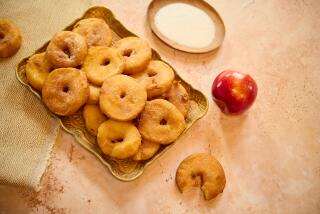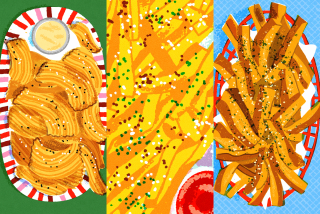Batter Out: Go for the Brown
- Share via
All batter-fried things taste the same; foods fried without batter have flavors of their own.
To put it another way, when you fry something in batter or breading, that’s what fries--what’s inside it just steams. (How wonderful. All the fat of fried batter combined with the blandness of steamed food.)
You may like that crust and its rich or crisp texture, but it will probably be most of what you taste, simply because steamed food has such a mild flavor. This is why people who order the mixed tempura plate often ask each other what they think they’re eating.
So why is there so much batter-frying in this world? Fast-food places like it because the frying oil can be reused longer, since it doesn’t pick up the flavors of a lot of different foods--it smells only of fried batter. For mass-production purposes, batter-fried foods are neater looking and pose fewer public health problems (they’re sort of hermetically sealed). In short, batter frying is convenient.
To heck with that. If you fry without batter--if you fry bareback--the food itself browns and becomes much more flavorful, with distinct flavor.
The Chinese call frying a violent cooking method. Instead of gently raising the heat through the whole piece of food, as do poaching and steaming, it directly exposes the surface to high heat, which causes the intense physical and chemical changes of browning.
Browning doesn’t start taking place until the temperature is about 100 degrees above the boiling point. Around 310 degrees, the sugars caramelize in a very complex process that produces appetizing flavors.
Slightly before caramelizing starts, proteins and other food elements undergo the even more complex Maillard reaction.
Among its many products are chemicals known as pyrazines, which are responsible for the flavors of browned meat and bread crust--and of coffee, chocolate, dark beer, chile peppers and quite a few other things--but they’re just the start. Every fried food will have its own tribe of aromatic compounds.
And they’ll be loud flavors too. That’s why hearty stews usually call for browning the meat, and sometimes the vegetables too.
Theoretically, you shouldn’t have to use oil to fry something; just the hot surface should be able to do it. But in practice, foods tend to curl as they fry, and many aren’t flat enough to be in uniform contact with the pan in the first place. Without hot oil to convey heat to the surface of a slice, eggplant, for instance, will just develop scorched spots alternating with areas that are, in effect, only baked.
Actually, in the case of eggplant, this oil-less frying happens to produce an interesting flavor reminiscent of corn. Unfortunately, it’s hard to cook a slice of eggplant all the way done this way without burning a lot of it. When eggplant is fried without oil this way, it’s often finished in stew so that it cooks thoroughly.
Browning has limitations--it’s usable for only relatively small pieces of food--and it does extract a price. Since it takes place well above the boiling point, it inevitably dries the food out somewhat, making for a less luscious texture.
Also, fried food is not only fattier but less nutritious than unfried. At the same time that the Maillard reaction makes amino acids tastier, it makes them less digestible; you absorb less protein from browned meat.
Fortunately, this isn’t a serious problem until the meat is so overcooked it’s unpalatable. Browning also produces some carcinogens, but again, unless the food is badly overcooked, the quantity isn’t significant.
Sure, there’s a certain truth to baseball great Satchel Paige’s advice: “Avoid fried foods; they angry up the blood.” But I’d add, “Anyway, hold the batter. Life’s too short to eat batter-fried food.”
TWICE-FRIED EGGPLANT STEW
Buraniyya, a dish of fried eggplant mixed with lamb stew, was one of the most popular dishes of the medieval Near East. It is still made in Morocco, though naturally the stew part no longer follows the medieval recipe--it’s a modern Moroccan stew. But buraniyya has died out east of North Africa. This fairly rich recipe, combining fried eggplant with yakhni (a modern Lebanese stew), is a speculation about what Lebanese buraniyya would be like if it existed.
STEW
2 onions, diced
3 tablespoons oil
2 to 3 cloves garlic, chopped
1 1/2 pounds boneless beef or lamb
2 tablespoons tomato paste
2 cups water
1/8 teaspoon cinnamon
Ground allspice
1/4 teaspoon salt
Juice of 1 lemon
Cook onions in oil in large skillet over medium heat until golden, 10 to 15 minutes. Add garlic to skillet and stir 1 minute. Cut meat in 1-inch chunks and add to skillet. Saute, stirring frequently, until meat has changed color.
Dissolve tomato paste in water and add to skillet. Season with cinnamon, pinch of allspice, salt and lemon juice. Reduce heat to low, cover skillet and cook until meat is very tender, 1 to 2 hours.
FRIED EGGPLANT
1 large eggplant
Salt
1/2 cup oil or more for frying
3 cloves garlic
Juice of 1 lemon
Cooked rice, optional
Lemon wedges
Peel eggplant and cut into slices 3/16 to 1/4 inch thick. Sprinkle generously with salt and place slices in colander to drain 15 to 20 minutes.
Rinse slices and pat dry. Cook eggplant slices, 3 to 4 slices at a time, in oil in large skillet over medium-high heat (slices should not touch). Fry on both sides until flesh is dark tan and seeds quite brown, 5 to 7 minutes. As slices are done, remove with slotted spoon to paper towels to drain, adding more oil as needed. Reserve frying oil.
Press garlic cloves. Mash eggplant slices with garlic and lemon juice, or puree together in food processor. Fry in reserved oil over medium heat until moisture is driven away, about 20 minutes. Drain oil from eggplant mixture and stir into stew. Serve with rice and lemon wedges.
Makes 4 servings.
Each serving, without rice, contains about:
458 calories; 329 mg sodium; 79 mg cholesterol; 34 grams fat; 13 grams carbohydrates; 28 grams protein; 0.94 gram fiber.
FRIED AIOLI
This is one recipe for which the garlic slicer-shredder that showed up in cookware stores a year or so ago is the perfect tool. Note that although many recipes such as this one call for uncooked eggs, the U.S. Department of Agriculture has found them to be a potential carrier of food-borne illness and recommends that diners avoid eating raw eggs. Eat at your own risk.
1 head garlic
1 cup oil
Juice of 1/2 lemon
1/4 teaspoon salt
Ground mustard
1 egg yolk
Peel garlic cloves and slice thin. Cook garlic slices in oil in large skillet over medium heat, stirring occasionally to prevent clumping, until cloves are light tan, about 5 minutes. Strain oil into bowl and allow to cool. Either discard fried garlic chips or reserve to use as garnish for some other dish.
In mixing bowl, stir lemon juice, salt and generous pinch mustard. Beat in egg yolk. Beat in cooled frying oil, few drops at a time to begin with, then in slow, steady stream, until mayonnaise is thickened.
Makes 1 cup.
Each 1-tablespoon serving contains about:
127 calories; 38 mg sodium; 17 mg cholesterol; 14 grams fat; 1 gram carbohydrates; 0 protein; 0.03 gram fiber.
DRY-FRIED EGGPLANT STEW (Oturtma)
In Turkey, this stew is usually made with eggplants fried in oil or butter, but this Syrian version fries them without.
2 pounds eggplant (2 globe or 7 long eggplants)
1 tablespoon oil
1 pound ground lamb
1/4 cup (1 ounce) pine nuts
1/4 teaspoon ground cinnamon
1/4 teaspoon ground allspice
1 teaspoon salt
2 tablespoons plain yogurt
1/4 cup tomato paste
2 cups water
1 green bell pepper or 2 jalapen~o chiles
Slice eggplants 1/4 to 3/8 inch thick and cook, several pieces at a time, in dry skillet over medium heat until light tan on both sides, about 5 minutes.
When finished, reserve eggplant and wash and dry pan, if necessary. Add oil, lamb and pine nuts and fry until meat loses pinkness. Drain oil. Add cinnamon, allspice, salt, yogurt, tomato paste and water. Add eggplant, bring to boil, reduce heat to medium and cook uncovered 45 minutes. Serve with sliced peppers as garnish.
Makes 4 servings.
Each serving contains about:
402 calories; 666 mg sodium; 63 mg cholesterol; 29 grams fat; 20 grams carbohydrates; 20 grams protein; 2.42 gram fiber.
FRIED-APPLE PIE
Frying makes the apple slices more flavorful. You might even want to leave the nutmeg out to emphasize the pure apple flavor.
FRIED FILLING
7 to 8 apples, peeled, cored and sliced
1/4 cup butter
1/4 cup sugar
1/8 teaspoon nutmeg, optional
1/4 teaspoon grated lemon peel
1 teaspoon lemon juice
Fry apple slices in butter, in batches as necessary until softened and slightly brown. Stir in sugar, nutmeg, lemon peel and lemon juice.
CRUST
2 cups flour
1/2 teaspoon salt
1/4 cup butter
1/4 cup lard
About 1/2 cup water
Sift flour with salt. With fingertips, work butter and lard into flour until mixture resembles coarse cornmeal. Stir in enough water to make dough that holds together. Roll out 1/2 dough 10 inches in diameter and line 9-inch pie pan. Pour apple filling into pan. Roll out remaining dough to make top crust; seal edges with fingers and make several holes in crust.
Bake pie at 450 degrees 10 minutes. Reduce temperature to 350 degrees and bake until crust is golden and filling is bubbling, 40 to 50 minutes longer.
Makes 8 servings.
Each serving contains about:
352 calories; 265 mg sodium; 37 mg cholesterol; 19 grams fat; 45 grams carbohydrates; 3 grams protein; 0.69 gram fiber.


